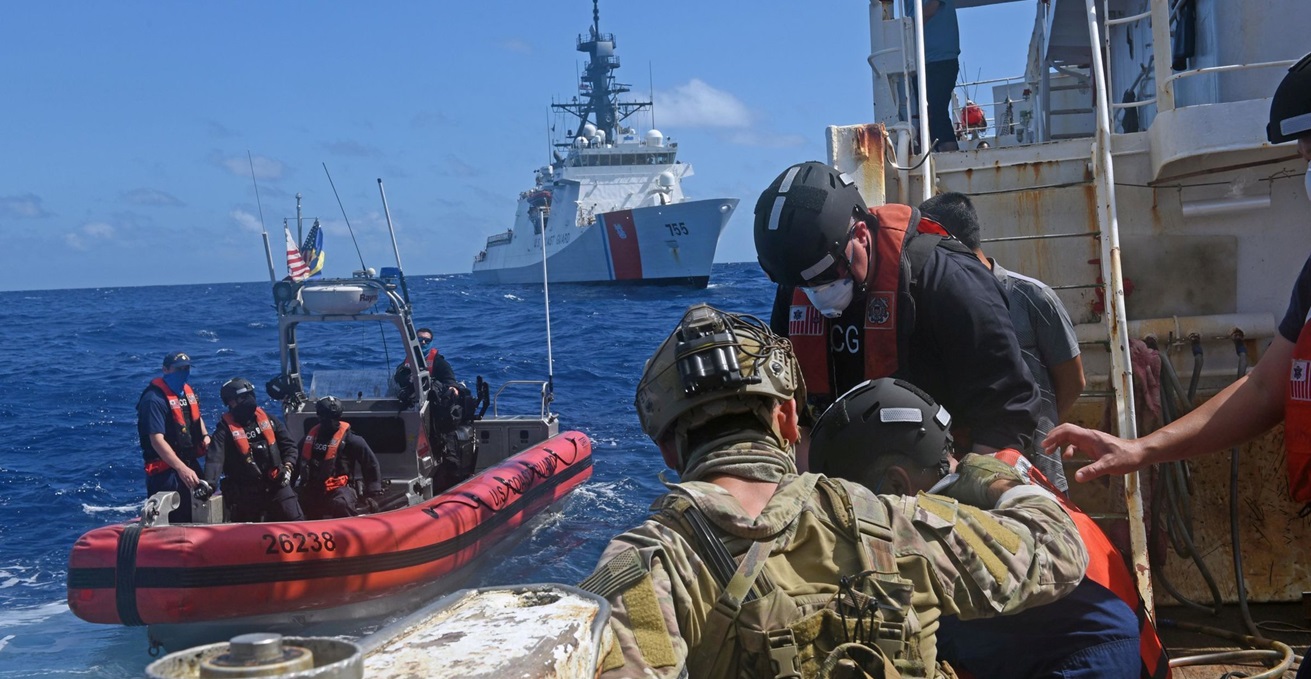Its Time for A Pacific Maritime Security Program for Southeast Asia

Southeast Asia’s maritime environment faces threats from piracy, slavery, and illegal, unreported, and unregulated (IUU) fishing. A maritime security program tailored for the region may address these issues while drawing partners closer to Australia.
Australia’s maritime trade geography consists of a confluence of lines to the nation’s north and through Southeast Asia. Around 40 percent of Australia’s trade is funnelled through these waterways and chokepoints, making the threat of maritime piracy, sea slavery, and illegal, unreported, and unregulated (IUU) fishing a challenging and complex issue. Australia must look for strategies to build maritime security in the important region to its north if it is to remain resilient and prosperous into the future. Improving the maritime stability and capacity of Southeast Asia and Australia’s partners in the region facing maritime threats will be essential in ensuring Australia’s long-term security.
Regional coast guards, navies, and other maritime law enforcement entities have limited resources to patrol and monitor illegal activities within their sovereign waters. These bodies further lack inter-state cooperation which has hampered collaborative responses to security threats such as maritime piracy.
Maritime piracy has the potential to significantly impact Australian shipping, but just sailing around the problem isn’t a viable solution; alternative routes increase travel time, require additional port stops, and may be too shallow for most container ships. Australia must further consider the danger of piracy dispersing to areas potentially less equipped to deal with these threats, such as the Pacific. The dangers of insecurity around maritime chokepoints have been illustrated in recent Yemeni Houthi attacks on commercial ships transiting the Red Sea, with vessels rerouting around the Cape of Good Hope. Disruption has caused shipping delays, additional costs in fuel and surcharges, and has overburdened ports unused to increased shipping traffic.
Sea slavery and IUU fishing provides for another challenge, and one that is increasingly likely to impact Australia as fish stocks continue to plummet in Southeast Asia. An estimated 17,000 workers on fishing vessels around Southeast Asia could be classified as slaves, an ongoing issue arising from interrelated economic factors such as declining fishing stocks caused by climate change and overfishing, along with rising oil prices, creating conditions ripe for crew exploitation. Sea slavery and IUU fishing are organised maritime crimes representing risks for Australia, notably, in that these enterprises are diminishing finite natural resources and are often linked to a myriad of other crimes that can disperse to other seas.
Many enterprises engaging in sea slavery and piracy are further interconnected with IUU fishing, which was described as the leading global maritime security threat by the US Coast Guard in its 2020 Strategic Outlook. Southeast Asian fishing vessels often illegally enter Australia’s maritime boundaries, and regional nations experienced a reported economic loss of over US$6 billion in 2019 from IUU fishing, with Indonesia in particular losing around US$201 billion from 2013-2018.
Regional governments have been unable to fully address these threats. Systemic issues such as poor socio-economic conditions in coastal communities, significant gaps in welfare and income between regional nations, and corruption and collusion with pirates within the regional maritime industry have until now provided substantial roadblocks to mitigation. This environment offers not only a risk to Australian maritime trade security, but an opportunity to work with partners to address these threats through a regional version of the Pacific Maritime Security Program (PMSP).
The PMSP is an AUD$2 billion Australian commitment to enhance the maritime capability of its Pacific neighbours, and includes the provision of patrol boats, long-term training, and maritime infrastructure such as wharfs. In-country advisors, maritime asset maintenance, and region-wide integrated aerial surveillance utilising targeted intelligence-driven patrols are also included. Sailors from participating countries can further undertake specialist studies in a TAFE Queensland Pacific Maritime Training Services program.
A 2021 Australian Parliamentary sub-committee inquiry into Australia’s defence relationships with Pacific Island nations found that these partners greatly benefitted from these provision. The relationship also directly enhanced their individual maritime security, as well as providing capacity to participate in regional patrol and surveillance operations. Regional interoperability and coordination have increased, and Australia has gained an additional avenue to develop long-term relationships and interoperability with partners in the region. Undoubtedly, this has increased Australia’s own maritime security.
The implementation of a similar Southeast Asian PMSP may offer an opportunity to deepen Australia’s existing regional partnerships and assist Australia in securing important trade routes. Funding could further be allocated towards addressing issues of regional governance and local investment to address the legal and economic causes of piracy, slavery, and IUU fishing.
Precedence for a Southeast Asian PMSP already exists in actions such as the 2015 gifting of Landing Craft Heavy Vessels to the Philippines and could be modelled upon examples of intraregional maritime security cooperation such as the Malacca Strait Patrol arrangement between Malaysia, Indonesia, and Singapore. This form of initiative could address concerns raised by Captain Michael Beard of the Royal Australian Navy that potential shortfalls in Australia’s maritime strategy produces risks to Australia’s shipping routes from foreign interference or aggression. Issues include a lack of focus on trade protection in current Australian naval strategy, limited interoperability with maritime industry, and the absence of maritime trade within the nation’s broader national security strategy.
A Southeast Asian PMSP would further add to regional coast guard capabilities that are currently under resourced. While countries such as Vietnam, Indonesia, the Philippines, and Malaysia have sought to expand their coast guard capabilities through vessel and sailor development programs, more is still required. The Philippines, for instance, have reached their goal of building a 30,000-sailor coast guard in 2023, with a further 4,000 to be recruited in 2024. Their aim is to establish a 100,000 strong coast guard, though to do so, it will need considerable support. Similar trends towards building coast guard and maritime law enforcement capability are evident in nations such as Vietnam and Thailand.
A regional PMSP involving coast guard engagement would undoubtably deepen partnerships with Australia and its partners and promote its commitment to maintaining stability and a rules-based international order. Such a commitment would join New Zealand, Japan, and the US who have existing defence or coast guard cooperation arrangements with Southeast Asian nations. Further capability and institutional development in Australia would lend credibility to new minilateral or multilateral maritime arrangements. Such initiatives would go far toward enhancing maritime trade security, but also may become increasingly important for nations facing territorial encroachment from China within sovereign waters around the South China Sea. Security pacts such as AUKUS and the Quadrilateral Security Dialogue have formed to counter China’s growing hegemony and coercion, but smaller Southeast Asian nations do not possess the same ability to develop such powerful security groupings.
Southeast Asia is a region of strategic significance for Australia, not only for maritime trade but also as a security gateway to the nation’s north. Maritime insecurity arising from threats such as piracy, IUU fishing, and slavery in Southeast Asia has the potential to significantly impact Australia through trade disruption and through risks generated from organised transnational crime within the region’s waterways and dispersing into Australia’s environment. A Southeast Asian PMSP has the potential to assist partners address these threats individually and collectively, as well as improve their own security and capacity against foreign powers, generate prosperity, and allow Australia to build long-term, meaningful cooperation in the region.
Shaun Cameron is a public servant living in Canberra. He has a background in international relations, psychology, and teaching.
This article is published under a Creative Commons License and may be republished with attribution.





